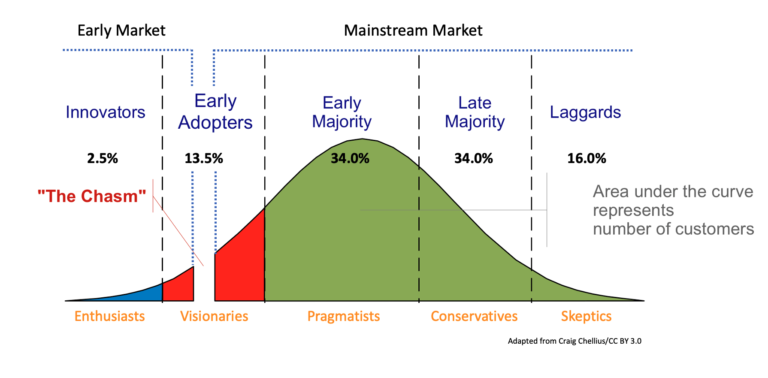
3: Wanted. Early Adopters
Founders obsess about making their first few sales. It’s convincing the Early Adopters to buy that you have to worry about.
Getting the first order for your product or service is a major milestone in the life of a new company. It’s a moment for celebration! I myself know the joy that comes from having someone buy the thing you have put your heart and soul into creating.
Truth be known, it’s not actually that hard to make the first sale. Just find some Innovators: they love to buy new stuff! That’s why they support Kickstarter, for instance, where entrepreneurs ‘Bring a creative project to life’.
Innovators are a peculiar, and much sought after, group of customers. The dictionary definition of an innovator is:
“a person or group that introduces something new or does something for the first time.”
They are the vanguard. You find them in all markets – individuals in business to consumer (B2C) and companies in business to business (B2B). Innovators consider themselves enthusiasts who like the appeal of new tech; they actively seek out novelty for the cachet of being first to own it, or the potential competitive advantage it could offer. Think technology that’s marketed as ‘revolutionary’ or ‘breakthrough’. These are the gadget freaks who queue at retail stores on the first day a consumer electronics company launches a new smartphone, or a startup datacenter equipment manufacturer that designs in the latest silicon or optical device into its hardware platform. Yet, according to studies like the ‘diffusion of innovations’ (DOI) model by Everett M. Rogers in his ground-breaking book of the same name (AKA ‘technology adoption curve’), Innovators represent a tiny part of the market, maybe just 2.5% of buyers.

The next group of customers is called Early Adopters. They represent around 13.5% of all buyers. They are visionaries or opinion formers who seek some tangible improvement over what they currently use, yet they are confident buyers willing to take some risk in purchasing a new to market product. Importantly, other buyers look to them before considering a purchase themselves.
These two groups – Innovators and Early Adopters – are pioneers. Representing a bloc of some 37% of all customers, combined they form the ‘early market’. Crucial to your commercial success, of course, is to win a lot more customers – and to keep them buying.
The uphill task facing a new company is to attract and convert the ‘mainstream market’, which is the bulk of customers in a market space. Predictably, achieving penetration of these buyers is harder. The ’big time’ for a company only really happens when the Early Majority is convinced to buy your product. Representing some 34% of the customer base, practicality drives their purchase decisions. They are followers not leaders.
Late Majority customers are conservatives (with a lower case ‘c’). They need assurance of the reliability of a new technology before committing their money. Representing some 34% of the customer base, they tend to stick to brands they know from companies they trust.
Last, but not least, are the remaining 16% of customers somewhat unfortunately labelled Laggards. This group is skeptical about new technology and prefers to stick to the tried and tested and will generally switch only when it has reviewed all the evidence from customer reviews, test reports, and testimonials.
As a startup founder your mission is to gain traction in the early market to drive growth among the customers in the mainstream market. To achieve this, key to your success is to design and build products and services with sufficient appeal to the majority of Early Adopters. These customers are the testing ground for your bundle of features, advantages, and benefits, combined with other crucial parts of the offer (which we will examine in the next chapter). Fail to get the mix right and your offering will more than likely not appeal to mainstream buyers. This point of resistance or failure in the DOI model is called the ‘chasm’ in Geoffrey A. Moore’s insightful and bestselling book Crossing the Chasm.
To traverse this virtual chasm, you must thoroughly understand your product offering from the Early Adopter’s, rather than the Innovator’s, viewpoint. Validating your product offering with the visionaries rather than with the tech enthusiasts will enable you to anticipate which elements of the value bundle resonate with buyers in the mainstream groups – and which don’t. This crucial step in new product development affords you the opportunity and time to fine tune the bundle before you launch. This should improve its chances of appealing to Early Majority customers – the very ones who will drive your ramp-up in sales revenues and profits. Validating with Early Adopters could help prevent your company from falling into the chasm; failing to do so could be harmful to your commercial wellbeing.
Lindsay Powell is a Partner and Co-founder of TYLIPH Partners, which offers its clients access to people with actionable insights to position new tech companies for long-term success.
© Tyliph Partners |
